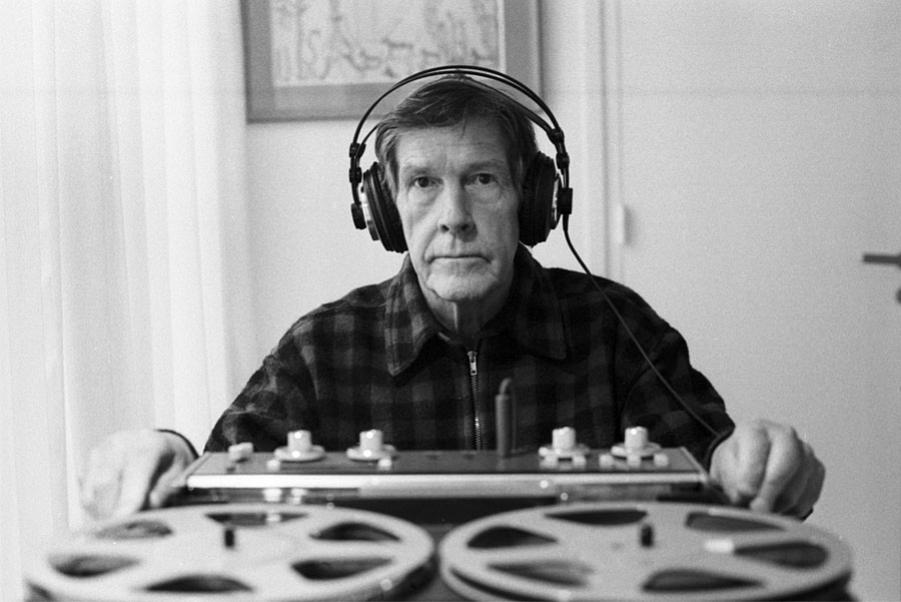THE FUTURE OF MUSIC: CREDO
By John Cage

I BELIVE THAT THE USE OF NOISE
Wherever we are, what we hear is mostly noise. When we ignore it, it disturbs us. When we listen to it, we find it fascinating. The sound of truck at fifty miles per hour. Static between the stations. Rain. We want to capture and control these sounds, to use them not as sound effects but as musical instruments. Every film studio has a library of ,,sound effects,, recorded on film. With a film phonograph it is now possible to control the amplitude and frequency of any of these sounds and to give to it rhythms within or beyond the reach of the imagination. Given your film phonographs, we can compose and perform a quartet for explosive motor, wind, heartbeat, and landslide.
TO MAKE MUSIC
If this word ,,music,, is sacred and reserved for eighteenth – and nineteenth – century instruments, we can substitute a more meaningful term: organization of sound.
WE CONTINUE AND INCREASE UNTIL WE REACH A MUSIC PRODUCED THROUGH THE AID OF ELECTRICAL INSTRUMENTS
Most inventors of electrical musical instruments have attempted to imitate eighteenth- and nineteenth- century instruments, just as early automobile designers copied the carriage. The Novachord and the Solovox are exemples of this desire to imitate the past rather than construct the future. When Theremin provided instrument with genuinely new possibilities, Thereministes did their utmost to make the instrument sound like some old instrument, giving it a sickeningly sweet vibratio, and performing upon it, with difficulty, masterpieces from the past. Although the instrument is capable of wide variety of sound qualities, obtained by the turning of a dial, Thereministes act as censors, giving the public those sounds they think the public will like. We are shielded from new sound experiences.
The special function of electrical instruments will be to provide complete control of the overtone structure of tones (as opposed to noises) and to make these tones available in any frequency, amplitude, and duration.
WHICH WILL MAKE AVAILABLE FOR MUSICAL PURPOSES ANY AND ALL SOUNDS THAT CAN BE HEARD. PHOTOELECTRIC, FILM, AND MECHANICAL MEDIUMS FOR THE SYNTHETIC PRODUCTION OF MUSIC
It is now possible for composers to make music directly, without the assistance of intermediary perfomers. Any design repeated often enough on a sound track is audible. Two hundred and eighty circles per second on a sound track will produce one sound, whereas a portrait of Beethoven repeated fifty times per second on a sound track will have not only a different pitch but a different sound quality.
WILL BE EXPLORED. WHEREAS, IN THE PAST, THE POINT OF DISAGREEMENT HAS BEEN BETWEEN DISSONANCE AND CONSONANCE, IT WILL BE, IN THE IMMEDIATE FUTURE, BETWEEN NOISE AND SO-CALLED MUSICAL SOUNDS.
THE PRESENT METHODS OF WRITING MUSIC, PRINCIPPALY THOSE WHICH EMPLOY HARMONY AND ITS REFERENCE TO PARTICULAR STEPS IN THE FIELD OF SOUND, WILL BE INADEQUATE FOR THE COMPOSER, WHO WILL BE FACED WITH ENTIRE FIELD OF SOUND.
The composer(organizer of sound) will be faced not only with entire field of sound but also with the entire field of time. The “frame” or fraction of a second, following established film technique, will probably be the basic unit in the measurement of time. No rhythm will be beyond the composer’s reach.
NEW METHODS WILL BE DISCOVERED, BEARING A DEFINITE RELATION TO SCHOENBERG,S TWELVE-TONE SYSTEM.
Schoenberg’s method assigns to each material, in a group of equal materials, its function with respect to the group. (Harmony assigned to each material, in a group of unequal materials, its function with respect to the fundamental or most important in the group.) Schoenberg,s method is analogous to a society in which the emphasis is on the group and the integration of the individual in the group.
AND PRESENT METHODS OF WRITING PERCUSSION MUSIC.
Percussion music is a contemporary transition from keyboard-influenced music to the all-sound music of future. Any sound is acceptable to the composer of percussion music. He explores the acasemically forbidden “non-musical” field of sound insofar as is manually possible.
Methods of writing percussion music have as their goal the rhythmic structure of a composition. As soon as these methods are crystallized into one or several widly accepted, the means will exist for group improvisations of unwritten but culturally important music. This has already taken place in Oriental cultures and in hot jazz.
AND ANY OTHER METHODS WHICH ARE FREE FROM THE CONCEPT OF FUNDAMENTAL TONE.
The principle of form will be our only constant connection with the past. Although the great form of the future will not be as it was in the past, at one time the fugue and at another the sonata, it will be related to these as they are to each other:
Before this happens, centers of experimental music must be established. In these centers, the new materials, oscillators, turntables, generators, means for amplifying small sounds, film phonographs, etc., available for use. Composers at work using twentieth-century means for making music. Performances of results. Organization of sound for extra-musical purposes theatre, dance, film, radio, etc,)
THROUGH THE PRINCIPLE OF ORGANIZATION OR MAN’S COMMON ABILITY TO THINK.
